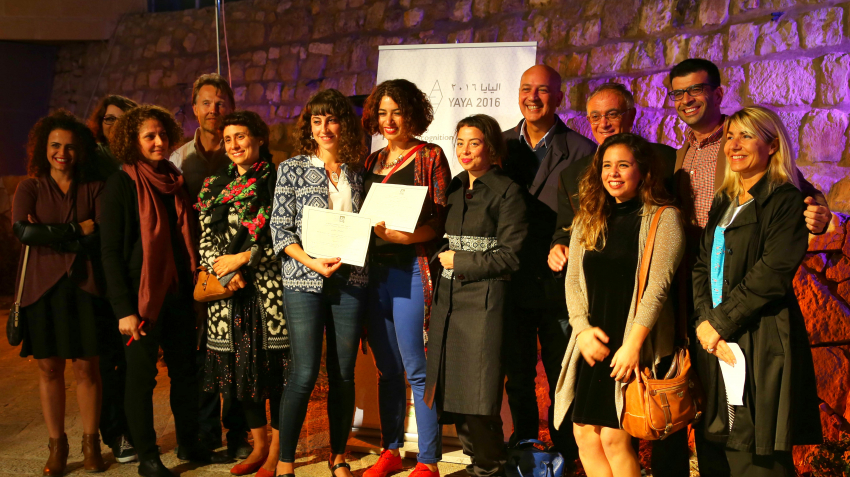
The first prize goes to Inas Halabi.. The second to Somar Sallam, and the third to Asma Ghanem
The A.M Qattan Foundation announced on Monday, 10th of October 2016, the winners of the 9th edition of the Young Artist of the Year Award (YAYA 2016)- The Hassan Hourani Award. The ceremony was hosted at Beit Saa- Old Town Ramallah.
YAYA 2016
Jury Statement
Rarely is a prize so welcomed, anticipated and celebrated as it is here. This is a testimony to the meaning and significance of the Young Artist of the Year Award for Palestinian artists, and its importance for dreams, aspirations and possibilities. The jury would first like to commend the Qattan Foundation for their constant efforts to bring the far, wide and varied Palestinian geographies and artistic practices together, and for creating opportunities for artists.
We would also like to congratulate the curator, Nat Muller, for her engagement, her hands-on approach, and her ability to work closely with artists of different realities, opportunities, accessibilities and mobilities – and who have different equalities of opportunities. This fact is reflected in the exhibition.
With this in mind, the jury faced a challenging task for several reasons. Firstly, the constraints placed on the YAYA award itself: the difficulty the artists faced of working with two specific themes, the Qalandiya International one of This Sea Is Mine, and the curatorial theme Pattern Recognition. And secondly, a curatorial process which in some cases resulted in presentations that were perhaps not those the artists had originally privileged. And the greatest challenge of all: the immobility that some of the laureates are limited by: that is, that one artist is once again unable to overcome the Gaza blockade to be here with us, while another other has fled from Syria to Algeria.
Taking these points into account, we made our decisions on the basis of the works exhibited in the exhibition of the 2016 YAYA Award, and on the potential that we see in the artists to develop their practices.
The jury decided to award the Third Prize to Asma Ghanem for her sonic venture, ‘Homeland Is…’ The jury thought the artist challenged her own practice by breaking out into a new medium and experimenting in territories outside her comfort zone. The jury was impressed by the idea to render history by means of sound, by the artist’s desire to actively engage the public, and her translation of the score as rhythmical mapping. We are awarding this prize to encourage the artist to continue to pursue this avenue and to delve even deeper into historical research, to engage more actively in field work, and in experimentation with sound synthesis.
The Second Prize is awarded to Somar Sallam for her video work Disillusioned Construction. The jury was impressed by the strong associative power of the work, and its ability to convey loss and the vicious cycle of construction–reconstruction–destruction that is part of the experience of settlement and resettlement, by means of a language that fuses the sculptural, the corporeal, the performative and the filmic, with a profound economy of means. The work is a result of both domestic conditions and means of production, testifying to the fact that art can happen even when scarcity is the norm.
The First Prize is unanimously awarded to Inas Halabi for her video work Mnemosyne, which revisits a scar on her grandfather’s forehead. In the video Halabi individually asks members of her extended family to recite the story behind the scar. What amounts is a rich, sometimes contradictory, mosaic of varying stories that point to the relativity and instability of memory. Each retelling has slight differences and nuances to the point that one uncle enacts it in the first person. During the filming, the narration is interrupted when some of the family members pause to take a sip of water – a symbolic reference to Lethe, the trap of forgetting. With minimal means, Inas Halabi was able to deconstruct official narratives and work instead with the permeability of histories. She subverts the theme of repetition and return – a theme often recycled in contemporary Palestinian art – in a refreshing, dispassionate and truly objective way, by avoiding the clichés of victimisation, and the spectacularisation of trauma.
Before we congratulate and celebrate the artists, we have to mention that the decision-making process was darkened by the terrible accident that occurred yesterday, while we were deliberating, in the construction site directly adjacent to offices of the Qattan Foundation. Tragically, two workers were killed while others were injured when the scaffolding suddenly collapsed. Our thoughts go out to the families of the victims.
Finally, we would like to point out that while research is an integral component of the YAYA process, the jury feels, in the case of all the artists, it was not developed as far as it could have been. With the desire to constructively contribute to the potential and development of the prize, the jury would like to recommend that artists are allowed more time for this process. We would also like to encourage the artists to dig deeper into the research process – whether material, conceptual, or historical – and enrich their artistic practice with the dialogues that the work instigates.
